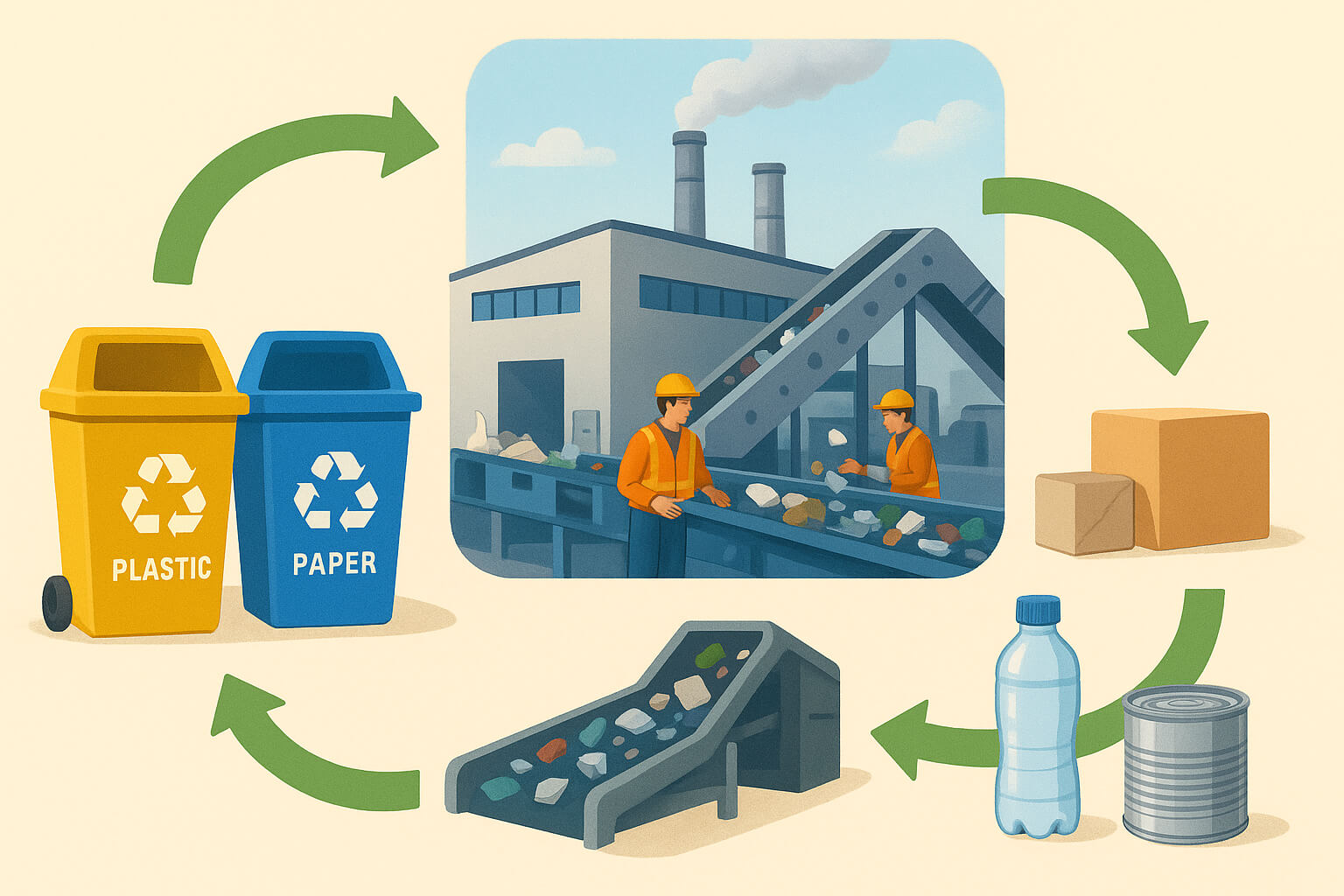Recycling is often portrayed as a simple act—toss a bottle in the bin, and you’ve helped save the planet. But what really happens after that bottle leaves your hands? And how effective is recycling at solving the complex global waste problem?
To fully appreciate the value of recycling, we must look beyond the blue bin. Understanding the science, systems, and limitations behind recycling is essential if we hope to reduce pollution, conserve resources, and transition toward a truly circular economy.
The Journey of Recyclables: From Bin to New Life
When recyclable waste is collected from homes or businesses, it enters a highly coordinated chain of processes designed to recover as much usable material as possible.
Step-by-Step Breakdown:
- Collection & Transportation
- Recycling trucks transport collected materials to a Material Recovery Facility (MRF).
- Sorting
- At the MRF, recyclables are separated using a combination of manual labor and advanced technology:
- Magnets remove metals like steel.
- Eddy currents sort aluminum.
- Infrared scanners and air jets identify different types of plastics.
- Trommel screens separate items by size and weight.
- Cleaning & Baling
- Sorted items are cleaned to remove food residue, adhesives, or labels. Then, materials are compacted into bales (e.g., plastic, aluminum, paper) for shipment to specialized processors or manufacturers.
- Remanufacturing
- These bales become raw inputs for creating new products:
- Aluminum cans: Recycled and back on shelves in as little as 60 days.
- Plastic bottles: Transformed into textiles, insulation, or new containers.
- Paper: Repulped into newspaper, cardboard, or tissue products.
- Glass: Melted down and endlessly recyclable without quality loss.
Recycling significantly reduces the energy required to manufacture products from raw materials. For instance, recycling aluminum saves up to 95% of the energy needed to produce it from bauxite ore.
For more on how waste is transformed into new resources, visit this visual guide on recycling and plastic pollution.
Why Recycling Matters More Than Ever
Recycling isn’t just about clearing clutter—it’s a critical tool in the global effort to combat pollution, conserve resources, and slow climate change.
Environmental Benefits:
- Waste Diversion: In 2018, recycling and composting kept 94 million tons of waste out of landfills and incinerators (EPA).
- Energy Savings: Manufacturing with recycled materials typically consumes 30% to 95% less energy than using virgin resources.
- Pollution Prevention: Recycling reduces the need for extraction and processing of raw materials, which lowers air and water pollution.
Resource Conservation:
- Saves trees (paper recycling)
- Reduces water usage (plastic and textile recycling)
- Decreases mining and drilling (metal and oil extraction)
Climate Action:
- Recycling helps lower greenhouse gas emissions by reducing energy use and preventing methane emissions from landfills.
When combined with composting, recycling becomes even more powerful. Composting organic waste reduces methane—a potent greenhouse gas—and creates rich soil instead. Learn more in this guide on the importance of composting.
Common Misconceptions About Recycling
Despite the growing availability of recycling programs, confusion and misinformation still abound. Here are some of the most common myths—and the truths behind them:
- Myth #1: Everything with a recycling symbol is recyclable
- Reality: The triangle symbol (♻️) doesn’t guarantee recyclability. It simply indicates the type of plastic. Many municipalities only accept #1 and #2 plastics, such as PET and HDPE. Check local guidelines before recycling items like plastic clamshells, black plastic, or plastic bags.
- Myth #2: It’s okay to recycle items with food residue
- Reality: Contaminated materials (like greasy pizza boxes or yogurt containers with residue) can spoil entire batches of recyclables, causing them to be discarded. Always rinse and clean recyclables first.
- Myth #3: Recycling is enough to fix the waste crisis
- Reality: Recycling is essential—but not sufficient. The waste hierarchy prioritizes:
- Reduce consumption
- Reuse items
- Recycle only what can’t be reused or avoided
As highlighted in this sustainable living guide, minimizing waste at the source is far more effective than dealing with it afterward.
Innovations in Recycling: What’s Next?
Traditional recycling systems, while beneficial, have limitations. Fortunately, science and innovation are paving the way for more effective solutions.
Emerging Technologies:
- Chemical Recycling: Breaks plastics down into molecular building blocks, allowing materials like polystyrene or multilayer films (currently hard to recycle) to be reused.
- AI Sorting Systems: Improve sorting accuracy and reduce contamination.
- Closed-Loop Manufacturing: Products are designed to be recycled and reused indefinitely, reducing dependence on raw materials.
Policy and Community Involvement:
- Extended Producer Responsibility (EPR) laws require companies to manage the end-of-life of their products.
- Local governments are expanding access to curbside recycling and composting.
- Schools and organizations are educating future generations about sustainability, similar to environmental education programs that encourage lifelong eco-awareness.
Beyond the Bin: What You Can Do
Even with better technology and policy, personal action remains crucial. Here’s how you can contribute to a more effective recycling system:
Everyday Actions:
- Follow local recycling guidelines
- Avoid “wishcycling”—don’t toss items in the bin and hope they’re recyclable
- Buy recycled-content products to close the loop
- Reduce single-use items—opt for reusable bottles, bags, and containers
- Join or start community cleanups to reduce litter and plastic waste
Be a Conscious Consumer:
Support brands that use sustainable packaging, practice ethical sourcing, and invest in circular production models.
Conclusion: Recycling as a Gateway to Sustainability
The science of recycling shows us that waste isn’t the end—it’s a new beginning. Every bottle, can, or newspaper recycled reduces the strain on natural resources and energy systems. But recycling also serves as a gateway to broader sustainable behaviors.
By understanding the journey of waste and committing to responsible practices, we can help build a circular economy—where resources are reused, waste is minimized, and nothing is truly "thrown away."
“The greatest threat to our planet is the belief that someone else will save it.” – Robert Swan
Let’s each do our part—because small actions today lead to big impacts tomorrow.
